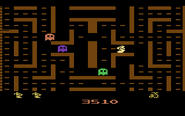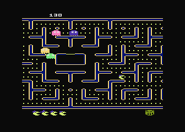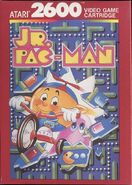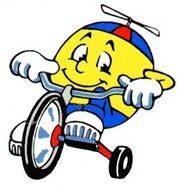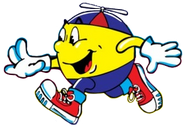Jr. Pac-Man is a maze arcade game in the Pac-Man series developed by General Computer Corporation and published by Bally Midway in 1983. It could be considered the follow-up to Ms. Pac-Man.
Gameplay[]
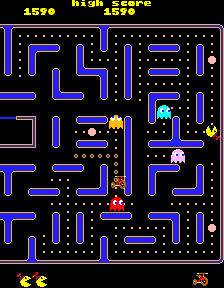
Screenshot of a game in progress. Jr. Pac-Man travels across a wide maze.
Jr. Pac-Man follows similar gameplay to its predecessors, Pac-Man and Ms. Pac-Man. The player controls Jr. Pac-Man as he attempts to eat all the dots within the maze while avoiding the four ghosts that pursue him in the maze: Blinky, Pinky, Inky and newcomer Tim. The round is cleared when all the dots and Energizers within the stage are eaten. If Jr. Pac-Man is caught by a ghost, he will lose a life. The game ends when all lives are lost. If Jr. Pac-Man eats an Energizer, he will gain the temporary ability to eat the ghosts for bonus points. In later rounds, the game speed increases, the ghosts become more aggressive and the Energizer effects are shortened. Depending on the maze, four to six Energizers are present within the maze. An extra life is awarded after reaching 10,000 points, though depending on the settings, this can either be 15,000 points, 20,000 points or no extra life bonus.
Jr. Pac-Man features seven different mazes throughout the game. Compared to its predecessors, the mazes in Jr. Pac-Man are now about three times as wide in comparison to the previous games. As Jr. Pac-Man moves across the maze, the camera will scroll along with him as he travels horizontally, though it will not follow any ghosts; making them obscured from view if they are far from the maze. If a ghost goes off screen, they will reverse direction to enter sight again. Unlike its predecessors, Jr. Pac-Man's mazes do not feature any Warp Tunnels.
Similar to Ms. Pac-Man, the ghosts will only briefly scatter at the start of the round before beginning to chase Jr. Pac-Man. All the ghosts pursue Pac-Man just as they did in Pac-Man (including Tim, whom targets Jr. Pac-Man just like Clyde).
Like its predecessors, bonus items appear within each level (they are now mostly toys instead of fruit) after Jr. Pac-Man eats several dots, which can be eaten for bonus points. Similar to Ms. Pac-Man, they will appear in on top of the Ghost House and bounces around the maze. The bonus items affect dots and Energizers when an item passes over them. When an item passes through dots, they will become larger dots that slow down Jr. Pac-Man more than regular dots but award 50 points. When an item passes through an Energizer after said item is present in the maze for a period of time, it will explode upon contact with the Energizer; destroying and removing both the item and Energizer from the maze; now posing a threat to the player. If the bonus item reaches an Energizer while it is off-screen, it will not explode until enters sight; if a life is lost during this event, the Energizer will not be lost. Any large 50 point dots present in the maze when a life is lost will also disappear from the maze upon losing a life.
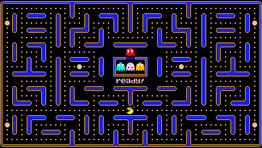
The original maze, which would normally scroll.
Differences from Pac-Man and Ms. Pac-Man[]
- The text font is different.
- The colors for the ghosts are slightly different.
- The mazes are three times as wide in comparison to its predecessors. As a result, the camera now scrolls based on Jr. Pac-Man's current position.
- The mazes change between every round instead of every 2-3 rounds.
- The bonus item now changes dots to larger dots when it passes over one, but can also destroy Energizers after the bonus item is present for a period of time.
- The remaining stock of Jr. Pac-Man lives now animate (specifically, his propeller cap).
- Due to the extended length of the mazes, harder difficulties are now present in earlier rounds, with faster speed and shorter Energizer effects.
- Intermissions now play at the end of rounds 1, 3, 5, 7 and 9 instead of rounds 2, 5, 9, 13 and 17 due to the longer maze length.
Scoring System[]
- Pac-Dot - 10 points.
- "Large" Dot - 50 points.
- Power Pellet - 50 points.
- Vulnerable Ghosts:
- #1 in succession - 200 points.
- #2 in succession - 400 points.
- #3 in succession - 800 points.
- #4 in succession - 1600 points.
- Bonus Items:
- 🚲 Tricycle: 100 Points
- 🪁 Kite: 200 Points
- 🥁 Drum: 500 Points
- 🎈 Balloon: 700 Points
- 🚂 Train: 1000 Points
- 🐈 Cat: 2000 Points
- 🍺 Root Beer: 5000 Points
Intermissions / Acts[]
The game's intermissions center around the developing relationship between Jr. Pac-Man and Yum-Yum (the daughter of Blinky). This game features three intermissions, which are similar to the ones found in Ms. Pac-Man:
- Jr Meets Yum-Yum: Jr. Pac-Man gets out of his house to play, and he sees Blinky alongside his daughter, Yum-Yum. He gets out of the yard to see Yum-Yum; Blinky, not accepting the potential relationship, tries to chase Jr. away. Ms. Pac-Man arrives to protect him by eating a Power Pellet, turning Blinky and Yum-Yum into blue ghosts, and Ms. and Jr. Pac go back in their house.
- The Gift: Junior finds Yum-Yum standing on a bridge, and gives her a balloon as a gift. Yum-Yum politely accepts the balloon, but unbeknownst to them, Blinky is secretly spying on them through a nearby bush.
- They Escape: Blinky gets out of the bush. As Yum-Yum quickly releases the balloon, Blinky tries to catch Jr. - but just as he is about to, Ms. Pac-Man comes again to protect her child by distracting Blinky, who starts chasing Ms. Pac-Man, while Jr. and Yum-Yum escape. They fall in love, surrounded by hearts.
Home Ports[]
- Atari 2600
- Was planned to release in 1984, but didn't come out until 1986.
- Mazes are completely different, and scroll vertically instead of horizontally.
- The music for the cutscenes plays after the level they normally appear on, but there are no actual cutscenes.
- Atari 400/800/XL/XE
- Retail release was canceled. A prototype has been found and dumped.
- Cutscenes are removed.
- Atari 5200
- Another canceled port, with a dumped prototype.
- Nearly identical to the Atari 400/800/XL/XE version.
- Commodore 64
- Mazes are smaller, and fit on one screen.
- Every cutscene is titled "They Escape" for unknown reasons.
- Bonus items appear way more often than usual.
- IBM PC
- Two separate versions were released: an CGA version and an EGA version (the latter having more colors).
- Nearly identical to the Commodore 64 version, but a loop of strange music is played instead of the traditional siren; the same music was used in the IBM PC port of Super Pac-Man.
- Plug & Play TV Game
- Canceled port from 2006, which was seemingly planned to be included on the Super Pac-Man Collection system by Jakks Pacific. It was presumably removed from the final product due to the complications with General Computer Corporation regarding Ms. Pac-Man, which had escalated around the time of the console's planned release.
- Additionally, the game's soundtrack can be found in the debug menu of Retro Arcade featuring Pac-Man.[1] This data doesn't seem to appear in the Super Pac-Man Collection, though its debug menu is largely inaccessible due to the console's lack of a B button.
- Rather than be built-in to the plug & play itself, it is possible that Jr. Pac-Man was intended to be released on a GameKey cartridge for a canceled "GameKey Ready" variant of the Super Pac-Man plug & play. However, one early promotional description suggests otherwise; stating that the "standard edition" Super Pac-Man system featured five games (the fifth presumably being Jr. Pac-Man), whereas the final release includes four games.[2]
Unlike Pac-Man and Ms. Pac-Man, which have both been ported to a plethora of different systems, Jr. Pac-Man has only received three home console releases to date (with two additional canceled versions). This is most likely due to both Atari going bankrupt in 1984, and Namco failing to secure the game's rights.
In the Sega Genesis version of Pac-Man 2: The New Adventures, there is an unlockable game titled "Pac-Jr."; however, this is actually a modified version of Ms. Pac-Man starring Jr. Pac-Man, rather than an actual Jr. Pac-Man port.
There are also homebrew versions of Jr. Pac-Man for the Atari 7800 and Intellivision. An official Atari 7800 version was reportedly planned, although the source of this claim is unclear; it is cited that its ID number is "CX7813", a number skipped in the officially released cartridges.[3]
Play Online[]
These versions of Jr. Pac-Man are either listed in the public domain or are considered abandonware. Clicking the game title will lead you to a playable online version of it from archive.org (mobile compatibility may vary).
- Recommended: Jr. Pac-Man (Atari 5200, 1984)
- Jr. Pac-Man (IBM PC, 1988)
Trivia[]
- According to both the U.S. Copyright Office and legal papers from the Namco-AtGames lawsuit (among other sources), Jr. Pac-Man was initially developed under the title of "Pac-Baby". The name and character were presumably changed to avoid confusion with the already released Baby Pac-Man.
- Several unused bonus items are present in the game's graphics data; these include a skateboard, a cowboy hat, a pogo stick, a rattle, a baby bottle, and a pacifier.[4] The latter three may indicate that these were the items used in its initial "Pac-Baby" form.
- Both the larger dots caused by bonus items, and the "Blast" graphic when a bonus item explodes, are based on unused material from the code of the original Pac-Man game. However, it is unclear if they perform the same functions in Jr. Pac-Man as they were planned to in Pac-Man, as the only remnant of them in Pac-Man's code are the graphics themselves.
- The beginning music in Jr. Pac-Man is likely a rendition of the "Junior" cutscene music in Ms. Pac-Man, with a few note patterns changed.
- In its arcade form, Jr. Pac-Man was sold as both a dedicated arcade machine and as a "conversion kit" set for preexisting Pac-Man games (namely Pac-Man, Ms. Pac-Man, and Super Pac-Man). For unknown reasons, the kits were much more common than the proper machine release, with the dedicated cabinets being somewhat rare.
- Presumably to reduce costs, dedicated Jr. Pac-Man arcade machines were actually repurposed Mappy cabinets, with cheaply made stickers covering the original artwork; if said stickers are ripped, the Mappy characters can be seen underneath.
- Curiously, one promotional flyer states that Mappy-to-Jr. Pac-Man conversion kits were also available for purchase. As other flyers state a dedicated machine was produced, it is possible the "dedicated" cabinet was merely a factory-built release of this conversion kit.
Gallery[]
Screenshots[]
Concept Artwork[]
Machine and Box Art[]
Character Artwork[]
References[]
- ↑ https://youtu.be/Wc4blsnDLmI?t=884 (at timestamp 14:44)
- ↑ "Get five times the Pac-Action! This awesome plug-and-play game features the original Pac-Man arcade game as well as four all-new games [...]" (https://web.archive.org/web/20071215100116/http://www.amazon.com/Jakks-Super-Pac-Man-TV-Game/dp/B000EDROHA)
- ↑ https://www.atari7800.org/7800list.htm
- ↑ https://tcrf.net/Jr._Pac-Man_(Arcade)


